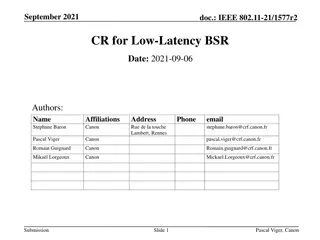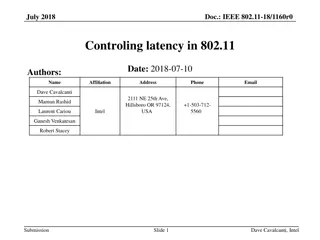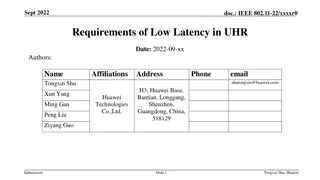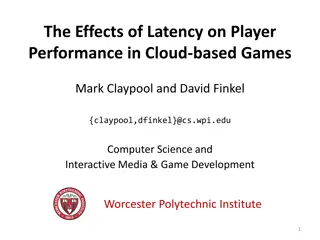Clipper: A Low Latency Online Prediction Serving System
Machine learning often requires real-time, accurate, and robust predictions under heavy query loads. However, many existing frameworks are more focused on model training than deployment. Clipper is an online prediction system with a modular architecture that addresses concerns such as latency, throughput, and accuracy. It supports multiple ML frameworks like Spark, scikit-learn, TensorFlow, and more, written in Rust. The system includes components for model selection and ensemble strategies to improve prediction accuracy and efficiency.
Download Presentation

Please find below an Image/Link to download the presentation.
The content on the website is provided AS IS for your information and personal use only. It may not be sold, licensed, or shared on other websites without obtaining consent from the author.If you encounter any issues during the download, it is possible that the publisher has removed the file from their server.
You are allowed to download the files provided on this website for personal or commercial use, subject to the condition that they are used lawfully. All files are the property of their respective owners.
The content on the website is provided AS IS for your information and personal use only. It may not be sold, licensed, or shared on other websites without obtaining consent from the author.
E N D
Presentation Transcript
Clipper: A Low Latency Online Prediction Serving System Shreya
The Problem Machine learning requires real time, accurate, and robust predictions under heavy query load. Most machine learning frameworks care about optimizing model training not deployment Current solutions for online predictions focus on a single framework
Clipper Online prediction system Modular architecture with two layers Paying concern to latency, throughput, and accuracy Written in Rust Support for multiple ML frameworks such as Spark, scikit- learn, caffe (computer vision), tensorflow, and HTK written in rust and has support for spark, scikit-learn, caffe (computer vision), tensorflow, and htk(speech recognition)
Model Selection Layer Selects and combine predictions across competing models for more accuracy. Most ML networks are optimized for offline batch processing not single input prediction latency Solution: batching with limits Receive a query: dispatches to certain models based on previous feedback
Selection Strategies Costly A/B online testing. It grows exponentially in number of candidate models. Select, combine, observe Select the best: Exp3 Ensemble select: Exp4
Selection Strategies Exp3: associate a weight si for each model. Select that model with probability si/sum of all other weights Updates the weight based on accuracy of prediction where the loss function is absolute loss [0,1] determines how quickly Clipper responds to feedback
Selection Strategy Use linear ensemble methods which compute a weighted average of the base model predictions Exp4 Additional model containers increase the chance of stragglers. Solution: wait according to latency requirement and confidence reflects uncertainty If confidence is too low uses default setting.
Model Abstraction Layer Caches predictions on a per model basis and implements adaptive batching to maximize throughput given a query latency target Each queue has a latency target Optimal batch size: maximizes throughput under latency constraint. Uses AIDM Reduce by 10% as optimal batch size doesn t fluctuate too much Dispatched via RPC system
Model Abstraction Layer Prediction cache for query and model used, LRU Bursty workloads often results in less than max batch size. Could be beneficial to wait a little longer to queue up Delayed batching
Machine Learning Frameworks Each model is contained in a Docker container. Working on immature framework doesn t interfere with performance of others Replication: resource intensive frameworks can get more than one container Could have very different performance across cluster
Machine Learning Frameworks Adding support for a framework takes < 25 lines of code To support context specific model selection (diatlect), model selection layer can instantiate a unitue model selection state for each user/context/session. Managed in external database (Redis)
Testing Tested against TensorFlow Employs static sized batching to optimize parallelization Used two containers one with the python and c++ api. Python was slow but c++ was near identical performance
Limitations Doesn t talk about system requirements Replicating containers with same algorithm could do some optimization with this to minimize latency (half in one and half to other to minimize batch size) Also doesn t mention not double counting the same algorithm
Related Work Amazon Redshift: shared nothing, can work with semi- structured data, time travel BigQuery: JSON and nested data support, has own SQL language, tables are append only, Microsoft SQL Data Warehouse: separates storage and compute, similar abstraction Data Warehouse Units, concurrency cap, no support for semi structured
Future Work Make Snowflake a full self service model, without developer involvement. If a query fails it is entirely rerun, which can be costly for a long query. Each worker node has a cache of table data that currently uses LRU, but the policy could be improved. Snowflake also doesn t handle the situation if an availability zone is unavailable. Currently it requires reallocating the query to another VW. Performance isolation might not be necessary so sharing a query among worker nodes could increase utilization.























